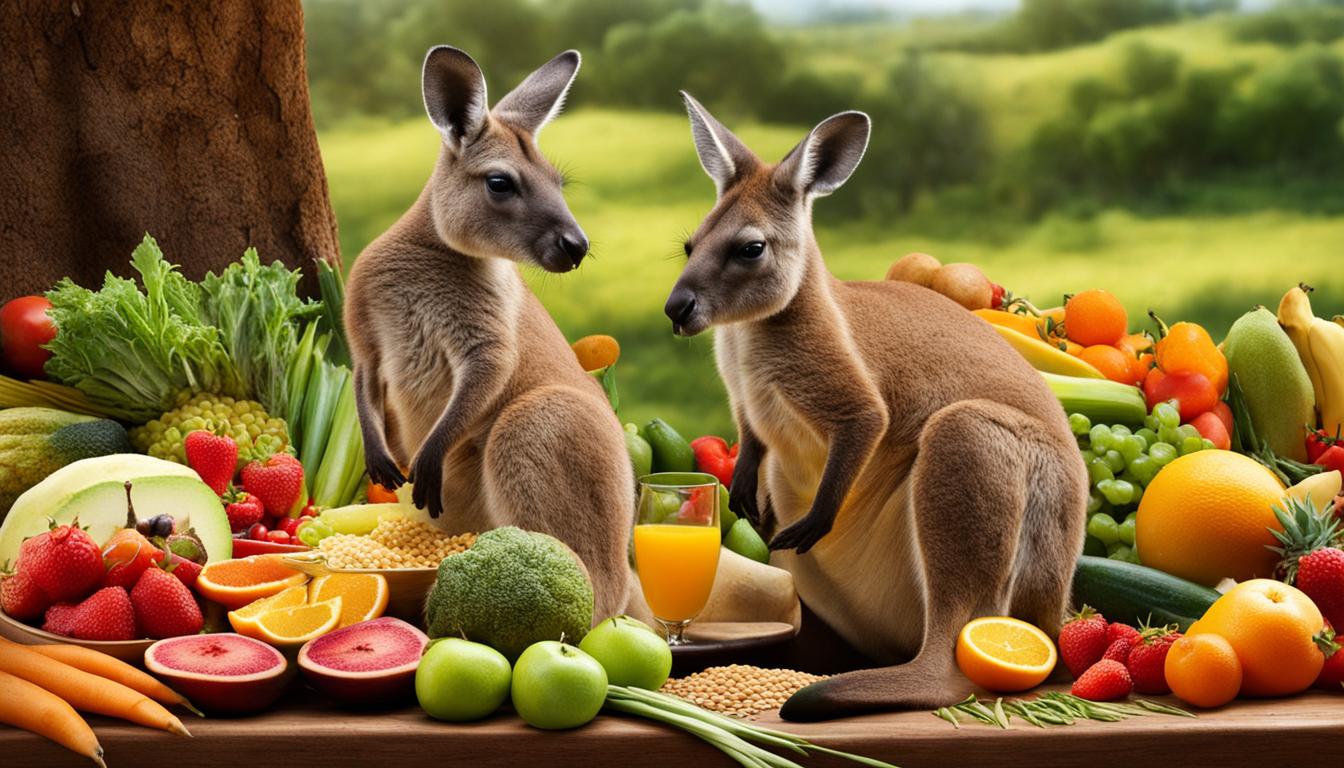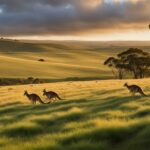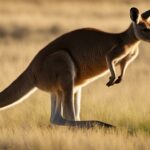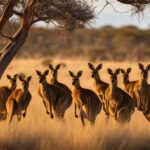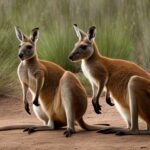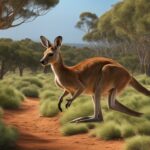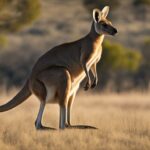When it comes to kangaroo diets, you might be surprised to learn that these incredible creatures have more culinary variety than you might think. While their typical diet consists of grass and vegetation, kangaroos do have other nutrition options depending on their species and habitat.
Before we dive into the details, let’s take a moment to appreciate the diverse diet of these amazing marsupials. Take a look at this captivating image showcasing the beauty of kangaroos in their natural habitat:
Now, let’s explore the different dietary preferences of various kangaroo species. From red kangaroos to Eastern grey kangaroos, each species has its own unique tastes and nutritional needs.
Kangaroo Dietary Needs and Feeding Habits
Kangaroos have specific dietary needs that depend on their species and size. Larger kangaroos, such as red kangaroos and Eastern grey kangaroos, primarily consume grasses. They have adapted to their habitat and can survive on low-nutrient grasses. Smaller kangaroo species, like wallabies, have a more varied diet and may eat fruits, seeds, fresh shoots, mushrooms, tubers, bulbs, roots, and flowers in addition to leaves.
Kangaroos are selective feeders and may have preferences for certain plant species. They forage during the late evening and night, and their feeding patterns are influenced by the availability of food in their environment.
To understand the dietary needs and feeding habits of kangaroos more comprehensively, the following table provides an overview of the primary food preferences of different kangaroo species:
| Kangaroo Species | Primary Diet | Additional Food Options |
|---|---|---|
| Red Kangaroo | Grasses, Shrubs | N/A |
| Eastern Grey Kangaroo | Grasses | Fruits, Seeds, Fresh Shoots, Mushrooms, Tubers, Bulbs, Roots, Flowers |
| Western Grey Kangaroo | Grasses | Low Trees, Leafy Shrubs |
| Antilopine Kangaroo | Short, Green Grasses | Portions of Burned Long Grasses |
Each kangaroo species has unique adaptations and feeding behaviors that allow them to thrive in their respective habitats. By understanding their dietary needs and feeding habits, we can better appreciate and protect these remarkable creatures in their natural environments.
Kangaroo Diet Preferences by Species
Different kangaroo species have specific diet preferences based on their habitat and adaptations. Understanding these preferences can help us appreciate the diversity of their feeding habits.
Red Kangaroos
Red kangaroos (Macropus rufus) primarily graze on grasses and some shrubs. They are well-adapted to arid and dry habitats, where grasses are abundant. This species has specialized teeth and digestive systems that allow them to efficiently process and extract nutrients from grasses. Their grazing patterns are influenced by the availability of green grasses, and they can also consume dry grass when green options are scarce.
Eastern Grey Kangaroos
Eastern grey kangaroos (Macropus giganteus) have a wider dietary range than red kangaroos. They feed on a variety of grasses and are the most populous kangaroo species. These kangaroos have a selective browsing behavior and may prefer certain grass species over others depending on factors such as seasonal availability and nutrient content.
Western Grey Kangaroos
Western grey kangaroos (Macropus fuliginosus) primarily graze on grasses like other kangaroo species, but they also consume low trees and leafy shrubs to supplement their diet. This allows them to access additional sources of nutrition when grasses are limited. Their feeding habits may vary depending on the environment and the availability of preferred vegetation.
Antilopine Kangaroos
Antilopine kangaroos (Macropus antilopinus) are found in the northern parts of Australia and have adapted to a diet of short, green grasses. Interestingly, they also consume the portions of long grasses that have been burned by bushfires. This adaptation enables them to utilize a food source that may not be accessible to other kangaroo species.
| Kangaroo Species | Diet | Feeding Behavior |
|---|---|---|
| Red Kangaroos | Grasses and shrubs | Grazing patterns influenced by green grass availability |
| Eastern Grey Kangaroos | Grasses and variety of other plants | Selective browsing depending on preference and availability |
| Western Grey Kangaroos | Grasses, low trees, and leafy shrubs | Supplement grazing with additional vegetation sources |
| Antilopine Kangaroos | Short, green grasses and burned portions of long grasses | Utilize burned grasses for food |
Each kangaroo species has unique adaptations and feeding behaviors that allow them to thrive in their respective habitats. By understanding their dietary preferences, we can better appreciate the fascinating diversity of kangaroos.
The Importance of Not Feeding Kangaroos
Feeding kangaroos in the wild may seem like a harmless and enjoyable activity, but it can have serious consequences for these unique animals. It is crucial to understand the risks and potential impacts of feeding kangaroos before engaging in such actions.
When you feed kangaroos human food, it can disrupt their digestive system, leading to illness and potential harm. Kangaroos have specialized diets that consist primarily of grass and vegetation, which provide them with the necessary nutrients to thrive. Introducing human food can cause digestive issues and imbalance their natural diet.
Additionally, feeding kangaroos can result in behavioral changes that are detrimental to their overall well-being. Kangaroos can become dependent on handouts and lose their natural foraging instincts. This reliance on unnatural food sources can lead to aggressive behavior and a decline in population due to malnutrition and inability to find adequate food.
Feeding kangaroos non-native foods can also expose them to new diseases and cause dental problems. Human food may contain ingredients that are harmful to kangaroos and can lead to severe health complications. To protect these iconic animals and ensure their long-term survival, it is essential to respect their natural diet and avoid feeding them.
| Risks of Feeding Kangaroos | Impact of Feeding Kangaroos |
|---|---|
| Disrupts digestive system | Behavioral changes and dependency |
| Potential illness and harm | Aggressive behavior |
| Inadequate nutrients | Population decline |
| Exposure to new diseases | Dental issues |
Conclusion
Kangaroos have a diverse diet that includes grass and vegetation, allowing them to adapt to different environments. Their feeding habits are influenced by their species and size, with larger kangaroos primarily consuming grasses and smaller species having a more varied diet. It is important to respect their natural diet and not feed them human food, as this can disrupt their digestive system and lead to aggressive behavior.
Feeding kangaroos can also cause them to become dependent on handouts and deviate from their natural foraging behaviors. This can result in starvation and a decline in population. Additionally, offering non-native foods can expose kangaroos to new diseases and dental issues, further impacting their well-being.
By allowing kangaroos to forage for their own food, we can ensure their nutrition needs are met and preserve their unique dietary preferences. It is crucial to remember that kangaroos are wild animals and should be respected in their natural habitats. Let’s appreciate the diversity of their diet and help protect their well-being for future generations to enjoy.
Are Kangaroos’ Varied Diets Related to any Other Interesting Facts about Them?
Kangaroos’ varied diets are indeed related to interesting kangaroo facts. These marsupials are herbivores, and their diet includes grass, leaves, and roots. Kangaroos also have a unique digestive system that allows them to maximize nutrient absorption from their plant-based diet.
FAQ
Do kangaroos eat foods other than their typical diet?
While kangaroos primarily eat grass and vegetation, their diet can vary depending on the species and their habitat. Some kangaroo species, like wallabies, have a more varied diet and may eat fruits, seeds, fresh shoots, mushrooms, tubers, bulbs, roots, and flowers in addition to leaves.
What are the dietary needs and feeding habits of kangaroos?
Kangaroos have specific dietary needs that depend on their species and size. Larger kangaroos primarily consume grasses and can survive on low-nutrient grasses. Smaller kangaroo species, like wallabies, have a more varied diet and may eat fruits, seeds, fresh shoots, mushrooms, tubers, bulbs, roots, and flowers in addition to leaves. Kangaroos are selective feeders and have preferences for certain plant species. They forage during the late evening and night, and their feeding patterns are influenced by the availability of food in their environment.
What are the diet preferences of different kangaroo species?
Different kangaroo species have specific diet preferences. Red kangaroos graze on grasses and some shrubs, Eastern grey kangaroos prefer a variety of grasses, Western grey kangaroos primarily graze on grasses but also feed on low trees and leafy shrubs, and Antilopine kangaroos graze on short, green grasses and may consume portions of long grasses that have been burned by bushfires.
Why is it important not to feed kangaroos?
Feeding kangaroos can disrupt their digestive system, potentially making them sick. Kangaroos can also become addicted to human food, such as carrots, which can lead to aggressive behavior and dependency on unnatural food sources. Feeding kangaroos can change their natural foraging behaviors, causing them to rely on handouts instead of foraging for their own food. This can lead to starvation and a decline in population. Additionally, feeding kangaroos non-native foods can expose them to new diseases and cause dental issues.
What is the conclusion about kangaroo diet and feeding?
Kangaroos have a diverse diet that primarily consists of grass and vegetation, but they can also consume other plant species depending on their habitat and species. It is important to respect their natural diet and not feed them human food. By allowing kangaroos to forage for their own food, we can ensure their well-being and preserve their unique dietary needs.

